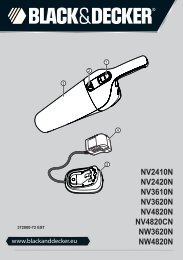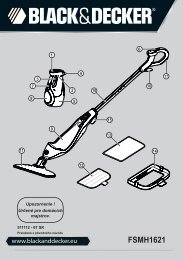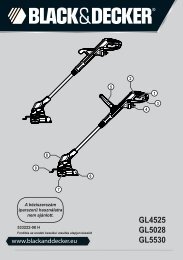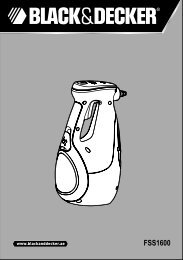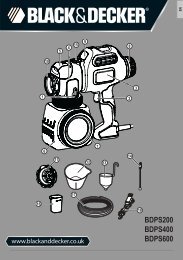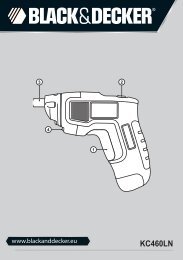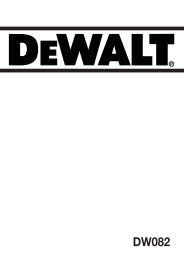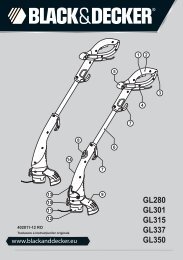HVLP200 - Black & Decker
HVLP200 - Black & Decker
HVLP200 - Black & Decker
Create successful ePaper yourself
Turn your PDF publications into a flip-book with our unique Google optimized e-Paper software.
(Original instructions)<br />
ENGLISH<br />
u Maintain smooth and consistent speed which will help<br />
avoid inconsistencies. Begin spraying after the pass has<br />
begun and release trigger before stopping the pass.<br />
u Avoid spraying too heavily in any one area. Several lighter<br />
coats are better than one heavy coat which can lead to<br />
running and dripping. Remember that the flow control<br />
knob regulates the amount of liquid that can be sprayed.<br />
Turning the flow knob clockwise increases the flow of<br />
liquid. Turning the knob counterclockwise decreases the<br />
flow of liquid. If runs or drips do occur, have a dry paint<br />
brush on hand to smooth them out.<br />
u Turn the power unit off and place the sprayer in the built-in<br />
dock of the power unit when not spraying for any length of<br />
time.<br />
Maintenance and cleaning<br />
Your <strong>Black</strong> & <strong>Decker</strong> corded appliance has been designed to<br />
operate over a long period of time with a minimum of maintenance.<br />
Continuous satisfactory operation depends upon<br />
proper appliance care and regular cleaning.<br />
Warning! Be sure to use appropriate personal protective<br />
equipment.<br />
Warning! Before performing any maintenance or cleaning on<br />
corded appliances switch off and unplug the appliance.<br />
Warning! Do not use materials with a flashpoint lower than<br />
55°C. Flashpoint is the temperature that a fluid can produce<br />
enough vapours to ignite (see paint supplier instructions).<br />
Warning! Make sure clean up area is well ventilated and free<br />
of flammable vapours.<br />
Warning! Always spray outdoors when spraying cleaning<br />
solution through sprayer.<br />
Warning! Do not submerse power unit.<br />
Flushing the sprayer (fig. N)<br />
u Disconnect the sprayer from the power supply.<br />
u Unscrew the lid from the side of the canister and pour any<br />
remaining liquid back into the original container (fig. N).<br />
u Pour a small amount of the appropriate cleaning solution<br />
into the canister.<br />
t Warm soapy water for water based materials.<br />
t Manufacturers recommended cleaning solution for oil<br />
based materials.<br />
u Replace the lid on the canister securely and vigorously<br />
shake the sprayer.<br />
u Unscrew the lid from the side of the canister and properly<br />
dispose of cleaning solution.<br />
u Refill the canister with a small amount of new cleaning<br />
solution. Screw lid securely on canister.<br />
u Reattach the sprayer to the motor unit, plug in the cord<br />
and turn on the power unit.<br />
u Spray the cleaning solution through the sprayer onto scrap<br />
material for 2 to 3 seconds.<br />
Cleaning the sprayer (fig. O - S)<br />
u Disconnect the sprayer from the power supply.<br />
u Remove the side fill canister (6) and unscrew the side<br />
lid (7). Remove the check valve (18), pickup tube (15)<br />
and o-ring (17) from the sprayer. Clean the parts in the<br />
appropriate cleaning solution (fig. O).<br />
u Unscrew the tip collar (19) and remove the spray nozzle<br />
(10) and spray tip (20). Clean all parts in the appropriate<br />
cleaning solution (fig. P).<br />
u If using water based material, clean the sprayer by running<br />
water through pickup tube inlet. If using oil based materials,<br />
clean pickup tube inlet with the appropriate cleaning<br />
solution. Repeat until sprayer is completely clean. Take<br />
special care to gently clean the spraying needle (21).<br />
u Dry all parts thoroughly.<br />
u Properly dispose of cleaning solution.<br />
u Place a drop of household oil onto the metal ball in the<br />
check valve (18) (fig. Q).<br />
Important : Lubricating the ball in check valve (18), after<br />
cleanup, will help to prevent it from sticking which can clog the<br />
valve and prevent adequate flow of spray material.<br />
Note : When reassembling, place metal ball end of check<br />
valve (18) into sprayer.<br />
u Reassemble sprayer (fig. S).<br />
Note : The spray tip (20) can only go in one way. The notch<br />
(22) on the spray tip must align with the recess in the threads<br />
of the sprayer (fig. R).<br />
Cleaning the power unit<br />
u Disconnect the sprayer from the power supply.<br />
u Use only mild soap and damp cloth to clean the power<br />
unit.<br />
Warning! Never let any liquid get inside the power unit.<br />
Warning! Never immerse any part of the power unit into a<br />
liquid.<br />
Cleaning the filter<br />
The power unit contains a washable/reusable filter (fig. T).<br />
Check the filter before and after each use. If dirty, wash with<br />
warm water and allow to air dry before re-installing or replace<br />
if necessary.<br />
u To check the filter, remove the filter cover (11) by removing<br />
the 2 screws from the top of the filter cover then pulling<br />
the cover off the power unit.<br />
u Remove the filter (23) and inspect.<br />
u Replace the filter and filter cover.<br />
Warning! Never operate the power unit without the filter in<br />
place. Debris could be sucked in and interfere with the function<br />
of the power unit.<br />
11



